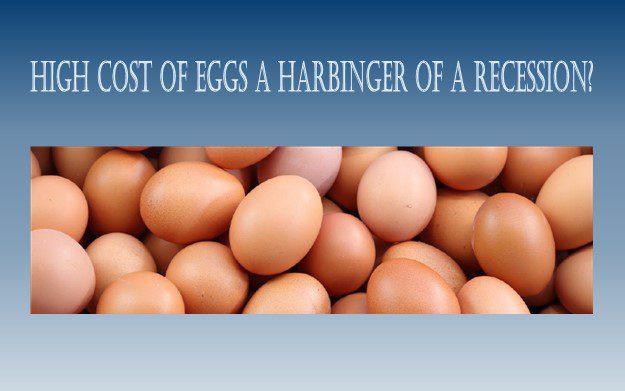High Cost of Eggs a Harbinger of a Recession?
No, there are more important economic indicators and factors to consider.
Eggs are a staple food item in households around the world, providing a rich source of protein and nutrients for a relatively low cost. However, as you undoubtedly noticed or read about, the cost of eggs has skyrocketed, leaving many consumers struggling to keep up with the rising prices.
In fact, according to data from the Bureau of Labor Statistics, the cost of eggs has risen more than any other food item in the past year. Last year, the average price for a dozen large Grade A eggs in the U.S. was $1.93 in January. By December, the price had skyrocketed to $4.25.
Reasons for the High Cost of Eggs
There are several factors contributing to the high cost of eggs. One of the main drivers of this increase is the widespread avian influenza outbreaks in recent years. Avian influenza, or bird flu, is a highly contagious virus that affects birds, and it has caused widespread damage to poultry populations worldwide. This has led to a significant decrease in egg production, driving up the cost of eggs as supply struggles to keep up with demand.
Another factor is the increasing demand for cage-free and organic eggs. Consumers are becoming increasingly concerned with animal welfare and are demanding eggs from chickens that are not confined to cages.
As a result, many egg producers have switched to cage-free production methods, which are more labor-intensive and result in higher production costs.
The cost of feed for chickens is also a significant factor in the high cost of eggs. Feed accounts for a large portion of the cost of egg production, and with the recent rise in grain prices, egg producers are struggling to keep up with the increasing cost of feed. This has resulted in higher costs for eggs, which are passed on to consumers in the form of higher prices.
Additionally, the rise in egg prices can be attributed to increased demand for eggs as a source of protein. As consumers become more health-conscious and focus on eating a diet rich in protein, the demand for eggs has skyrocketed. This has put further pressure on egg producers to meet the growing demand, resulting in even higher prices for consumers.
Cost of Eggs Indicative of the Economy?
The cost of eggs can reflect certain aspects of our economy, but it is not a comprehensive indicator of its overall state, because it is just one of thousands of factors that drives our economy.
Additionally, while the cost of eggs can reflect local and regional economic conditions, it may not always accurately reflect the national economy.
The cost of eggs can vary significantly across different regions, depending on local conditions such as supply, demand, and transportation costs.
More Important Factors to Watch
The overall state of the economy is influenced by a complex and interrelated set of factors, and the more influential factors include:
- Gross Domestic Product;
- Inflation;
- Employment Figures;
- Wages;
- Industrial Production;
- Home Sales;
- Home Building;
- Consumer Spending;
- Manufacturing Demand;
- Goods and Services Deficit;
- Retail Sales; and
- Government policies, among others
While the cost of eggs can provide some insight into our national economy, it is just not a comprehensive indicator of its overall state or a harbinger of a pending recession.
There are just too many more important economic indicators and factors to consider.
Copyright © 2023 FMeX. All rights reserved. Distributed by Financial Media Exchange.

